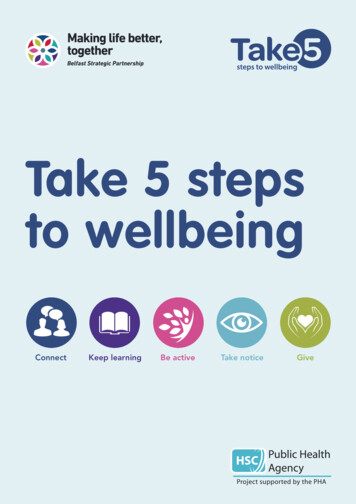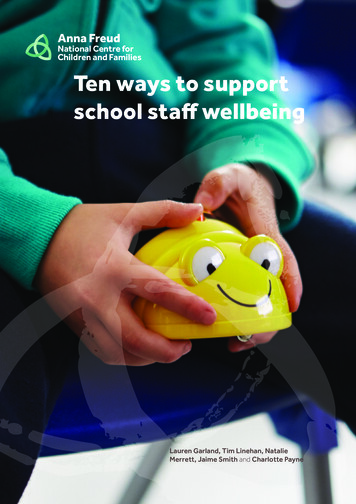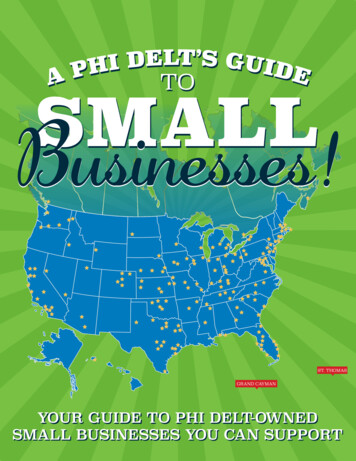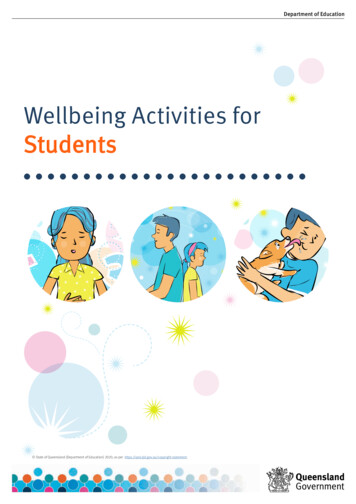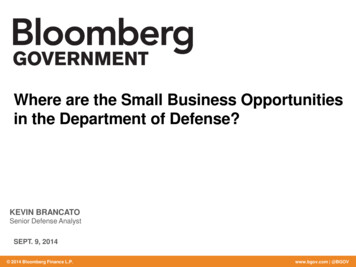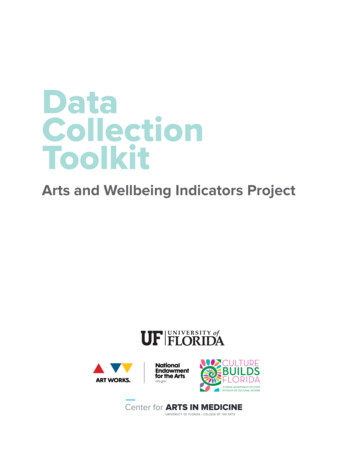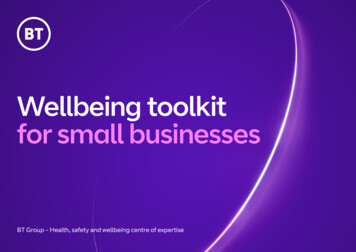
Transcription
Wellbeing toolkitfor small businessesBT Group - Health, safety and wellbeing centre of expertise
ContentsWelcome to the wellbeing toolkit 3The five drivers of wellbeing 4What can I do and where do I start? 7COVID-19 specific 9Things to think about 9What to do if you need more assistance or help 9The emerging health and wellbeingAdditional support 1118Additional resources 192
Welcome to the wellbeing toolkitThe wellbeing of ourcolleagues is important.And we know that supportingand working with them toimprove their wellbeing isimportant too. That’s wherethis toolkit comes in. It’shere to help SMEs look aftertheir own and their staff’swellbeing. The disruptionfrom the pandemic hasleft many small businessesand employees strugglingemotionally, as well asfinancially. Our recentresearch with SmallBusiness Britain highlightedthat 20% of small businessesfelt they needed mentalhealth support.The mental health and physicalwellbeing of our employees is alwaysour first priority. Throughout thecoronavirus crisis, we focused onincreasing awareness around bestpractice and bringing our colleaguesa range of support. And now, ourexpertise around best practice isbeing extended to small businessesto help them work their way throughthe challengesbeing thrownat them. Thiswellbeing toolkitis specificallyfor smallbusinesses, toprovide themwith hints, tipsand give themaccess to arange of free resources.Wellbeing is about ‘how we’re doing’as individuals, communities and asa nation.Personal wellbeing is how satisfiedwe are with our lives, our sense thatwhat we do in life is worthwhile, ourday-to-day emotional experiences(happiness and anxiety) and ourwider mental wellbeing. The five waysto wellbeing (connect, be active,take notice, keep learning, and give)can help us manage and improve ourpersonal wellbeing.Wellbeing is driven by so manyfactors, including our health, security,relationships, environment andpurpose. We call these the five driversto wellbeing. Wellbeing is more thanjust health all elementscontribute andaffect eachother, andthe way wework probablyimpacts on allof them.Lockdownhas beentough on all of us both physicallyand mentally. Many people havebeen furloughed, remained in theworkplace, or have been managingfamily or caring responsibilities whiletrying to work from home. Some arealso struggling financially as a directresult of the impact of COVID-19 ontheir business or workplace. In somecases people who have never felt orhave been vulnerable before are nowexperiencing a level of uncertaintythat is new to them. Some are feelingthe ongoing effects of ill health,be it directly related to COVID, ormanaging their mental and physicalhealth during challenging times.With restrictions lifting at differentspeeds and in different ways acrossthe world, and with the situationremaining extremely fluid, it’simportant to remember that life isn’tquite returning to how it was beforethe pandemic and its impact onpeople is far from over.As employers, we have a legal andmoral duty to address any workrelated issues affecting our peopleand a responsibility to support themthrough difficulties in their livesoutside work. That’s the right thingto do as well as being good forbusiness – and we want to offersimilar support and advice to theUK’s small businesses.3
The five driversof wellbeingEmployers can drive and support the wellbeing oftheir employees.We align to the ‘five drivers of wellbeing’ developed by theWhat Works Centre for Wellbeing.HealthWe all have a part to play inpromoting our own healthand wellbeing. Employershave a role in creating aculture, climate and workingconditions that enable theirpeople to make healthychoices and to flourish.Managers need to know theirpeople. They need to supportthem to promote good health,identify and manage earlysigns of ill health and pointthem in the right direction foradvice and services that helpthem stay in work or return towork after sickness.We all need to keep ourselvesas fit and healthy as we can, actearly if we feel unwell and makebest use of the information andservices available to us thathelps our recovery. Check out the One Youwebsite to help you gethealthier and feel betterwith free tips, tools andsupport. Healthtalk (via a charityorganisation) offersfree, reliable informationabout health issues bysharing peoples’ reallife experiences – thereare about 90 differenttopics including dealingwith cancer, autism,motor-neurone disease,pregnancy, drugs anddepression.HealthHappinessSecurityPhysical healthMental healthWork conditionsFinancial securityLife satisfactionJob satisfactionSubjectivewellbeingEnvironmentPhysical & systemsCultureRelationshipsLine managerColleaguesPurposeEngagementJob n work recoveryBarriers to recoveryPhysical problems from workplaceResilienceStressLine managerOrganisationAware of support formal/informalFinances & mental healthConfidence in futureAbility to withstand shockFairnessIdentify with valuesSupportRespectPersonal ng patternsToolsCommuteCommunicationSupportStretching & embracing growthAtmosphereFairnessChange managementClear goals & line of sightAccomplishmentMotivationAbility to influence decisionsCareer development / progressionWorkloadUse of skillsJob fitCompetence4
SecurityOur employer’s efforts to give us a secureand safe working environment, togetherwith how secure we feel at work, have asignificant impact on our wellbeing.Security encompasses our physical safetyat work; our working conditions; ouremployment status and assurance; andour perceived financial stability. There area handful of internal and external factorsthat can influence each of these things too.So we all have a role in promotion positivesafety and security.Safety - The most important thing we haveto do is make sure our people are alwayssafe. Remember, employers and theirpeople have moral and legal responsibilitiesto work safely. And it’s up to employersto set out the minimum standards for allaspects of health and safety as well asexplaining how to put it into practice. Plus,they’ve got to make the health and safetyframework clear to their employees so theyknow their safety is ensured. It’s importantthat employees understand the roles andresponsibilities, basic principles and riskmanagement process that you have in placeunderpinning everything that you do. The Health and Safety Executive(HSE) provides help and information tokeep people safe and healthy at work.One of your main responsibilities as anemployer is to make sure all employeesare following guidelines, includingthose relating to manual handling,working safely with display screenequipment, stress at work andmusculoskeletal disorders.Financial - ‘Financial security’ refers to thepeace of mind that we feel when we’re notworried about our income being enough tocover our expenses. It changes over timeand can be influenced by a wide range ofinternal (for example, feeling that your job isat risk, or increased cost of rent/mortgage),and external factors (for example, periodsof national economic recession). Sometimesour financial security can cause anxiety orstress, and affect our state of wellbeing. The Money Advice Service offers freeand impartial advice on a whole rangeof topics, from budgeting and managingmoney to renting or buying a home. It haswebchat via their website, you can call on0800 138 7777 or you can add 44 7701342744 to your WhatsApp contacts andsend a message (Monday to Friday, 8am- 6pm, Saturday 8am – 3pm, Sunday andBank Holidays closed). Citizen’s advice also offer free impartialadvice to help you make the rightchoices. Take a look at its debt andmoney section. Healthtalk (via a charity organisation)gives advice and reassurance for you orsomeone you care about on topics suchas making decisions about health andtreatment, talking to friends and family,practical issues like money and travel,emotional wellbeing and impact on workor education.5
RelationshipsThese include those in our personaland working lives, as well as those wehave with our employer, employees,the organisations we work with andthe wider community. All of theserelationships can impact on how wefeel, how we behave and ourgeneral wellbeing.All of us, either as managers orindividuals, have a key role insupporting and building strong,trusted, positive relationships in theworkplace, dealing with situationsfairly and decisively, as well as helpingour employees find support in dealingwith personal relationship issues.Employers should promote healthyrelationships for all their peoplewithin wider communities throughvolunteering, charity partnershipsand key programmes.EnvironmentWhen we talk about ‘theenvironment’ we often think aboutair quality, pollution in the seas andgreenhouse gasses but it’s also aboutthings much closer to home.Our environment is the space thatwe inhabit, physically and mentally.We all have basic needs of shelter,warmth and enough to eat and drink.If we don’t have those things we feelmiserable and eventually we willbecome ill.Those material things are importantbut simply adding more of them overand above what is necessary doesn’tmake us happier and they aren’tenough on their own.PurposePeople with purpose like what they’redoing and are motivated to achievetheir goals. Their purpose will stemfrom their values: what drives themand what really matters to them.There’s a strong link betweenpurpose and other aspects ofwellbeing. A strong sense of purposeis more likely to lead to improvedmental and physical health. Suchindividuals are more likely to beengaged with family, colleagues andthe community, with a positive impacton the quality of relationships. Beingsecure enhances individuals’ sense ofpurpose and engagement.Employers should ensure that peoplehave purposeful careers, where theymake a positive difference. Employersget the best from their people if theybelieve in the company they work for.They’ll be more likely to engage anddemonstrate their commitment totheir career, supporting colleagues,providing excellent customerservice and making an impact in ourcommunities if they have cleargoals and understand the impactthey’re making.6
What can I do and where do I start?Your employees will help you decidewhere to start and what to do.But only if you’re prepared tolisten. You’ve got to develop aculture within your company wherehaving supportive and constructiveconversations about mental healthand wellbeing is always welcome.That’ll help you identify wat needsto be done, while working with youremployees to address issues andfigure out solutions together.Remember, for many people thereare concerns, stresses, feelingsand fears that didn’t exist beforelockdown. This means there arevulnerable people in your workplacewho may have never felt vulnerablebefore. So, for many companies yourapproach to wellbeing will needto evolve to meet the changingneeds of your people. Have a readof COVID-19 wellbeing emergingissues for insights into the issues yourpeople may be facing.Start by thinking about what you already knowabout the wellbeing of your workforce. Andthen ask employees returning to the workplace,adapting to the new norm and/or new ways ofworking, how they feel and what they need. Thiscould include: Regular and effective comms on what’shappening and how they’re affected. Information on what’s being done to provide aCOVID safe work environment and guidanceon what they need to do. Equipment and/or training such as displayscreen equipment if they’re working fromhome. Time to reintegrate into the work placeand adapt to new ways of working. Consideration of personal needs such aschallenges with childcare, care for peoplewho are vulnerable. One-to-ones and supportive engagementwith managers. It’s important to note withoutan effective support network (which oftenincludes managers and colleagues as wellas family and friends) and where people arestruggling to deal with the direct impact ofCOVID-19 they’re much more likely to sufferwith poor mental health. Access to additional support services suchas an employee assistance programme orinformation on where to go for help. Seesection on additional support. Special consideration for employees who arein a higher risk group because of their healthor caring responsibilities or who may be morevulnerable because of a disability or longterm mental health illness.7
Some of these solutions won’t cost money or takemuch time to set up. Others may need funds andtake longer.It’s worth thinking about what your people aresaying they need and what’s achievable with thetime and resources you have available. But what’svery important is that you complete regular riskassessments of mental health, review and adaptyour plans accordingly.As well as asking your employees what they need,you might want to consider how effective yourleadership team is.Ask yourself: do your leaders, managers andsupervisors have the necessary awareness, skillsand attributes to support the wellbeing and themental health of employees withinyour organisation?Might they need training and supporton how to champion wellbeing andmetal health-related issues? Arethey seen as genuine, authenticand relatable when speaking aboutmental health issues?Do they recognise the importanceand value of improving the health,safety and wellbeing of youremployees and do they makegood role models by lookingafter themselves?Do they recognise their roleand responsibility in supportingemployees, such as keeping in regularcontact, managing remote workers insuch a way that doesn’t suggest theyare micro-managing the person anddon’t trust them?The impact that the leadership teamhave on employee wellbeing can’tbe overestimated.8
COVID-19 specificAlthough its been many months since the pandemicbegan, we’re still learning more about this diseaseday by day, and have a lot of unanswered questions.Things to think aboutIt’s important that employers clearlycommunicate messages to theirworkforce to take away any worriesand stresses linked to returning backto their workplace.Colleagues, customers and visitorsneed to know that your workplaceis COVID-secure. Employees alsoneed to know how you’ll managetheir workloads, their wellbeing, anyadjustments that are needed, andhow you’ll manage specialsituations such as those who areor have been shielding.Therefore we recommend that you: develop a strategy that keeps you,your workforce, your customersand visitors as safe as possible collaborate/discuss the strategy,where appropriate, with yourworkforce as you create it make sure that you communicateyour strategy clearly through themost appropriate media (briefpeople in person or bytelephone/conference call,confirm it in writing by email,print out leaflets/a booklet,update your website, put upclearly visible signage).What to do if you need moreassistance or helpThere are a number of government/professional bodies and organisationsthat can help you and your employeeswith COVID-19: You can get up-to-dateinformation on GOV.UK and thePublic Health England website. There is coronavirus informationfor people and businesses in: Scotland on the ScottishGovernment website Wales on the WelshGovernment website Northern Ireland on thenidirect website9
The Health and Safety Executive(HSE) COVID-19 pages providethe latest advice and guidancefor employers including how tomake changes to the workplaceto protect your people, assess therisk and be ‘COVID-secure’. The Advisory, Conciliation andArbitration Service (acas) givesemployees and employers free,impartial advice on workplacerights, rules and best practice.It also has a comprehensiveCOVID-19 section on its website,giving advice on working safety,social distancing and returning tothe workplace including advice forthose who have been shielding. The Chartered Institute forProfessional Development (CIPD)has a COVID-19: returning to theworkplace guide on its website,which will help you plan next stepsas lockdown measures are eased.It also has a helpful occupationalhealth factsheet, which outlinesthe kind of occupational healthservices an employer might offer. The Business Disability Forumhas a Coronavirus and disability:what you need to know sectionon its website, providing advicespecifically about coronavirusand disabled employees, whichcontains a COVID-19 toolkit to helpemployers identify and implementreasonable adjustments. The Faculty of OccupationalMedicine (FOM) has publishedan employer’s guide to engagingan occupational health physician;this is a doctor who specialisesin diagnosing and treating workrelated illnesses. The Society of OccupationalMedicine (SOM) is the UKorganisation for all healthcareprofessionals working in or withan interest in occupational health.It can help employers find anoccupational health provider,which gives them the services theyneed to support their employees’health and wellbeing, such assickness absence management,health surveillance, counselling(mental health service) andphysiotherapy (a musculoskeletaldisorder - MSK/MSD - service).of your recovery. It also providesinformation and support for family,friends and carers to help you bothduring recovery. The One You website can helpyou and your employees gethealthier and feel better withfree tips, tools, apps and supportfor your mind (Every mind matters)and your body. The UK governments’ smallbusiness helpline offers advice andfinancial help from governmentbacked schemes. The NHS Your COVID recoverywebsite. As you recover fromCOVID-19, you may still be comingto terms with the impact the virushas had on both your body andmind. This website helps you tounderstand what has happenedand what you might expect as part10
The emerging health and wellbeing issuesCommon concerns for people when returningto the workplaceAs we start to go back to our workplace, peoplemay have concerns and feel worried about it. This isa completely normal and natural reaction. Comingback to work after a period away can be difficultunder normal circumstances, let alone duringthese unprecedented difficult times.Employers play a vital role in supporting theirpeople. The first step is to talk your people, reallylisten and empathise – show you understand, careand want to help.Here are some common issues and concerns peoplemight have as they start to return the workplace.11
Anticipatory anxietyWhat is it? An uncomfortable feeling of nervousness, unease or worryabout something that is happening or might happen in the future.Anxiety levels have risen as a result of the pandemic. Although it’s to beexpected, it becomes an issue when it detracts from everyday life.How to spot it Avoiding situations Focusing on future events oractivities Distress in social situations Decreased concentration Tired/sleep disturbance Irritability/impatience Excessive fear Aches and shakesSocial interactions and sensory overloadWhat is it? People may become anxious when they think about having tobe in situations outside of their home such as commuting to work and theworkplace itself.These situations mean they’ll be in close proximity of others and not incontrol of the environment (noise, cleanliness, air quality).What you can do to supportyour peopleHow to spot itPoint them to these resources: Distress in social situations The self-help supportrecommended by Public HealthEngland as part of its every mindmatters campaign. Interpersonal conflicts NHS general anxiety disorder(GAD) overview. Mind – mental health charity(anxiety support). Avoiding of situations Anger/irritability/impatience Excessive fear/panic Hypervigilance (Also see signs and behavioursin anxiety section)What you can do to supportyour people Show you understand theirperspective. Agree a shared understandingof norms for the team withinthe workplace to help addressdifferent perspectives. Encourage any issues andconcerns to be flagged to youASAP. Encourage gradual exposureto the environment causingconcern. Consider the anticipatoryanxiety support options.Point them to this resource: The NHS Your COVID recoverywebsite – managing fear andanxiety section.12
Isolation/lonelinessWhat is it? Loneliness is a subjective feeling about the gap betweenhow much social contact someone wants and how much social contactthey actually experience. Returning to the workplace won’t necessarilyaddress this sensitive issue because COVID control measures will be inplace, such as social distancing, fewer interactions with people and splitteam attendance patterns.How to spot it Changes in mood andbehaviour. What you know about yourpeople and their circumstances,for example, if they’ve hadrecent bereavements,relationship break-ups, if theylive on their own, if they’re anextravert or an introvert. You should learn about signsassociated with depressionSleep problems and fatigueWhat is it? Changes to normal routines combined with uncertainty andincreased anxiety often express themselves by disrupting sleep andcausing fatigue.What you can do to supportyour peopleHow to spot itAsk and listen to what theybelieve will help and see if you canaccommodate it. YawningPoint them to these resources: The self-help supportrecommended by Public HealthEngland as part of their everymind matters campaign. Looking tired Irritability TearfulnessWhat you can do to supportyour peoplePoint them to: The NHS Your COVID recoverywebsite – sleeping well section Making more mistakes Mind, a mental health charity,can help explain loneliness andgive practical suggestions forwhat you can do and where youcan go for support. Home-Start, a local communitynetwork of trained volunteersand expert support, helpsfamilies with young childrenthrough their challenging times.Nearly two thirds of familieswho come to Home-Start forsupport say that isolation andloneliness is their main reasonfor needing help.13
Loss/depression/other underlyingmental health conditionsWhat is it? This unprecedented situation has had a significant impact,with many people experiencing loss in different ways such as: A person (friend or family) Way of life Lowered cardiac or lung capacity Certainty Reduced muscle strength A future The benefits of working from home Keep your eyes peeled for anychanges in behaviour from yourpeople’s norms. Here are somekey indicators for concern: Difficulty focusing Social withdrawal Irritability/emotionaloutbursts Less productivity/moraleproblems Lack of co-operation/contribution Safety problems Less care in personalappearance and hygieneWhat is it? A lot of people who are away from work for a long period oftime can find it difficult to come back. Following a normal routine anddoing their day to day job as normal could be a challenge because theymay be suffering from deconditioning or a lack or stamina.Prolonged inactivity can lead to: SafetyHow to spot itStamina and deconditioningWhat you can do to supportyour peoplePoint them to this resource: The NHS Your COVIDrecovery website – grief andbereavement section Direct employees to theirGP (NB some surgeriesallow patients to self-refer tophysiological services Mind – mental health charity(depression support) Every mind matters. The NHS Your COVID recoverywebsite – managing fear andanxiety section. Being more prone to injuryIt’s important to build up strength and fitness slowly.How to spot itTalk to the person: Ask them how they are, howthey’re feeling Breathless on exertion Possible weight gain Reduced muscle bulk orstrength Becoming tired during the day Lack of concentration SleepinessWhat you can do to supportyour peoplePoint them to this resource: The NHS Your COVID recoverywebsiteConsider any adjustments youcould make including a phasedreturn to work.Take extra steps for those whohave been shielding.See COVID-19 and its impact onphysical fitness. The Samaritans for free on 116123 (24 hours a day, 365 daysa year) or contact them byemail or letter if things are tooupsetting to talk about14
The long-term health impactsof COVID-19Emerging medical research andanecdotal evidence from recoverysupport groups suggest that manypeople who have had both severeand mild symptoms of COVID-19are experiencing lasting side effectsand prolonged recovery.As a result, rehabilitation is fastbecoming the new priority in dealingwith the impact of this pandemicand is crucial for people recovering.The Royal College of OccupationalTherapists has published threeguides to support people to managepost-viral fatigue and conservetheir energy as they recover fromCOVID-19. These guides areendorsed by the Intensive CareSociety and available as PDFs todownload and share with peoplewho are recovering. You can havea look at them here: Post viral fatigue guide Practical advice for people whohave been treated in hospital Post viral fatigue guide Practical advice for people whohave recovered at home Conserving energy guide Practical advice for peopleduring and after havingCOVID-19NHS England launched a servicefor people with ongoing healthproblems after having coronavirus.“Your COVID recovery” is an onlineportal for people in England toaccess tutorials, contact healthcareworkers and track their progress.Tailored rehabilitation is alsooffered to those who qualify,following an assessment.Employees experiencing difficultiesshould be encouraged to discussthese with their employer, reach outto family and colleagues. Peopleare usually willing to offer help andsupport, and it’s important not tofeel alone in your recovery.Nutrition plays a vital part in therecovery process for all patientswith COVID-19, particularly thosewho have suffered cardiac distress,pulmonary distress, or those whohave been critically ill. Take a look atour section on diet and nutrition foradvice on a balanced diet.15
COVID-19 and its impact onphysical fitnessThe benefits of achieving even theminimum level of activity include:The COVID-19 pandemic hascaused entire populations to gointo lockdown and live in homeconfinement for months, whichhas led to significantly less physicalactivity, affecting people of all ages,genders and ethnicities. It’s forcedsome people, even the youngest andfittest, to suddenly become inactive.Periods of lockdown make it hardfor people to do the sort of exercisethat they would normally do, likeexercising outdoors, going to the gymand playing sports. Helping maintain a healthybody weight. Lowering blood pressure. Decreasing the risk of heartdisease by at least 30%. Lowering the risk of type 2diabetes by at least 30%. Reducing the risk of certaincancers by at least 30%. Increasing muscle strengthand function. Improving bone health andstrength.To maintain muscle mass andmetabolic health, the best tip is tokeep moving. Resistance exercise,training that improves musclestrength and endurance, can bea positive way of fighting off thenegative effects of long periodswithout physical activity. Takingregular walks as a break from sinkinginto our sofa is helpful too.The Academy of Medical RoyalColleges published a report in2015 called Exercise, the Miraclecure, which promotes the benefitsof activity, and emphasises thedangers of inactivity. Physical activityimproves the people’s health withchronic conditions and prevents manycommon diseases, reducing the riskof each of these by 20% to 50%. Helping to promote positivemental health. Reducing the risk of dementiaby at least 30%.“ The message is simple: startslowly and build up - but dosomething.”A report from UK Chief MedicalOfficers (CMOs) of England,Scotland, Wales and Northern Irelandshows that, in general, the moretime spent being physically active,the greater the health benefits.Interestingly, the health gains areespecially significant for those whoare currently the least active, aseach minute of physical activity isproportionately better.Chief Medical Officers (CMOs)England, Scotland, Wales andNorthern Ireland16
Here’s a list of things we adultsshould aim to do: Aim to be physically active everyday. Any activity is better thannone, and more is better still. Do strengthening activities thatwork all the major muscles (legs,hips, back, abdomen, chest,shoulders and arms) at least twodays a week. (Weights, yoga, situps, burpees, pilates for example) Try to do at least one of these: 150 minutes of moderateintensity activity (briskwalking, gentle cycling tennis,gardening) each week. 75 minutes of vigorous intensityactivity (running, fast cycling,skipping, etc.) each week. Reduce the time you spendsitting or lying down and breakup long periods of not movingwith some activity.Coronavirus – know the risksand stay wellNow that we can get out and aboutmore, it’s really important we allcontinue to take care and do our bitto stop the rise in infection and stopa second spike.ourselves and those more vulnerablein our communities, by carefullyconsidering our actions and avoidinghigh risk activities to help us stay assafe as possible.With pubs and restaurants onceagain welcoming customers, it’s easyto feel excited that we’ve got ourindependence and freedom back.However, the virus is still very muchamong us. So let’s continue to protect17
Additional supportSupport for workers – events over the past months havebeen challenging and many people have looked to theirworkplace to provide them with support.Depending on what the need is, this can take manyforms such as insights into the pandemic, forums to raiseissues and concerns, access to an employee assistanceprogramme, occupational health service, opportunitiesto take part in online sessions that support wellbeing,such as mindfulness.There are a number of professionalbodies and organisations that can helpyou and your employees: The UK governments’ smallbusiness helpline – offeringadvice and financial help fromgovernment-backed schemes. The Advisory, Conciliation andArbitration Service (acas) - givesemployees and employers free,impartial advice on workplacerights, rules and best practice.They also offer training and
being extended to small businesses to help them work their way through the challenges being thrown at them. This wellbeing toolkit is specifically for small businesses, to provide them and give them access to a range of free resources. Wellbeing is about ‘how
